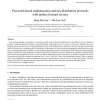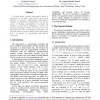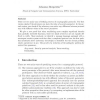25 search results - page 1 / 5 » Verifying Secrets and Relative Secrecy |
118
Voted
POPL
2000
ACM
15 years 4 months ago
2000
ACM
Systems that authenticate a user based on a shared secret (such as a password or PIN) normally allow anyone to query whether the secret is a given value. For example, an ATM machi...
112
Voted
JCSS
2006
15 years 23 days ago
2006
In an open networking environment, a workstation usually needs to identify its legal users for providing its services. Kerberos provides an efficient approach whereby a trusted th...
114
Voted
ENTCS
2000
15 years 19 days ago
2000
We lift Cardelli, Ghelli and Gordon's secrecy group creation operator [1] to a relative of the spicalculus that supports symmetric key cryptography, and show a natural extens...
108
Voted
ISCC
2009
IEEE
15 years 7 months ago
2009
IEEE
A directly public verifiable signcryption scheme is introduced in this paper that provides the security attributes of message confidentiality, authentication, integrity, non-repud...
90
Voted
ENTCS
2006
15 years 25 days ago
2006
There are two main ways of defining secrecy of cryptographic protocols. The first version checks if the adversary can learn the value of a secret parameter. In the second version,...



